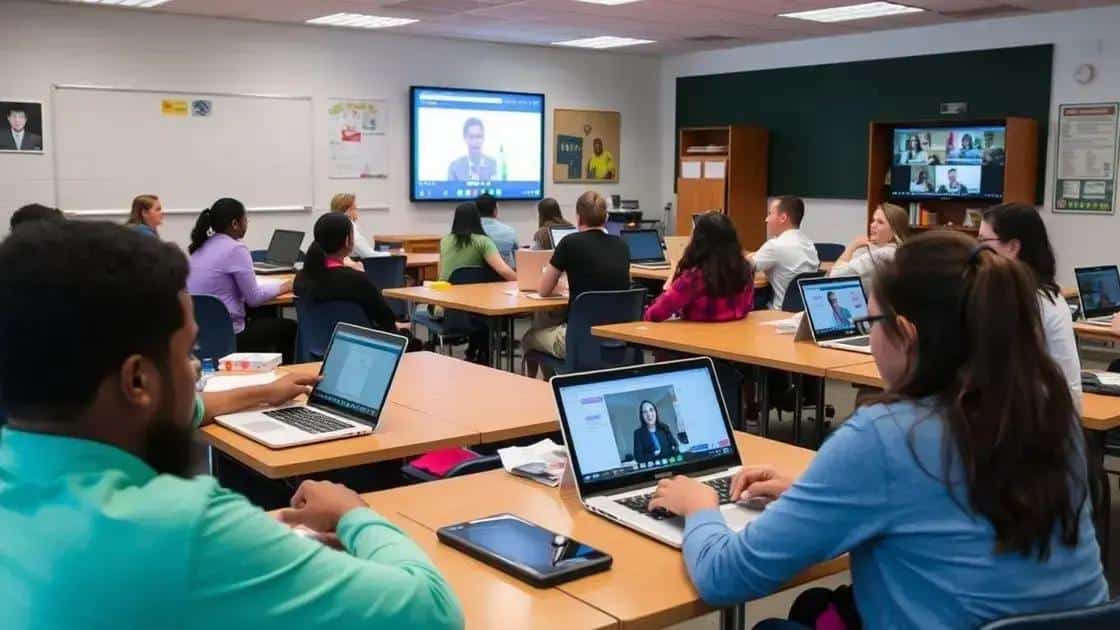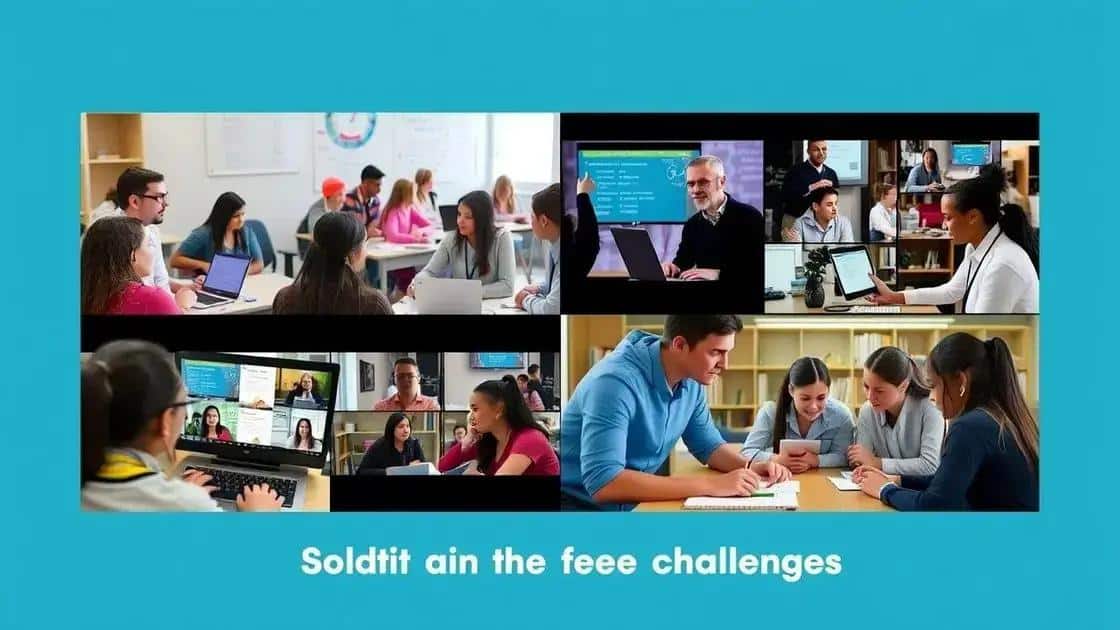Insights on hybrid learning success: Unlocking potential

Hybrid learning success relies on effective technology integration, maintaining student engagement, and addressing challenges like equitable access, enabling a flexible and inclusive educational experience.
Insights on hybrid learning success reveal how this blend of in-person and online education can reshape our learning experiences. Have you considered how flexibility might enhance your educational journey?
Understanding hybrid learning models
Understanding hybrid learning models is essential for educators and students alike. These models combine traditional face-to-face learning with online activities, creating a flexible and engaging educational experience. By leveraging technology, educators can provide students with various ways to learn, ensuring everyone has the opportunity to succeed.
The core components of hybrid learning
Hybrid learning can be broken down into a few key components:
- In-person instruction: This involves direct interaction between teachers and students in a classroom setting.
- Online learning: Students engage in learning materials and activities through digital platforms, allowing for asynchronous study.
- Blended assignments: Tasks often require a mix of both in-person and online work, enhancing collaborative skills.
- Flexibility: Students can choose how they want to learn, adapting to their personal needs and schedules.
One critical aspect of these models is the importance of communication. Educators must ensure that students can easily reach out for help and collaborate with their peers, regardless of their learning setting. This fosters a sense of community and support, both online and offline. Moreover, effective use of technologies, such as learning management systems, can streamline communication between students and teachers, allowing for timely feedback and guidance.
Benefits of understanding hybrid learning
Familiarity with hybrid learning models offers significant advantages. It equips educators to:
- Adapt to diverse learning styles: Different students thrive in different environments, and hybrid learning meets those varied needs.
- Engage students: Interactive online elements can boost motivation and make learning more enjoyable.
- Promote independence: Students develop self-regulation and responsibility as they navigate their learning journeys.
- Prepare for the future: Understanding technology in education prepares students for a digital world.
Ultimately, embracing and understanding hybrid learning models can lead to more effective teaching and improved student outcomes. As this approach continues to evolve, staying informed about best practices will be crucial for all educational stakeholders.
Key strategies for successful hybrid learning

Key strategies for successful hybrid learning focus on creating an effective learning environment that caters to all students. By understanding how to blend in-person and online education, educators can maximize engagement and learning outcomes. It’s vital to implement techniques that foster communication, motivation, and adaptability.
Effective communication
Establishing clear communication channels is essential in hybrid learning environments. Students should feel comfortable reaching out to teachers and peers. Utilizing platforms like chat apps and discussion boards can enhance interaction, making it easier to ask questions or share ideas.
- Regular check-ins: Schedule frequent meetings to discuss progress and challenges.
- Feedback opportunities: Encourage students to provide feedback on their learning experiences.
- Peer support groups: Create small groups for students to collaborate and support each other.
Another critical strategy is to incorporate technology effectively. Choosing the right tools can influence how well students grasp the content. Learning management systems (LMS) can centralize resources, assignments, and schedules. This organization makes it easier for students to stay on track and access materials.
Engagement techniques
To keep students motivated, it’s important to vary the types of activities offered. Incorporating interactive elements such as quizzes, videos, and discussions can make learning more dynamic. Additionally, offering choices in assignments allows students to explore interests while ensuring they meet learning objectives.
- Gamification: Using game-like elements can increase engagement and motivation.
- Interactive polls: Use polls during lessons to gather input and stimulate conversation.
- Real-world applications: Connect learning material to real-world situations to enhance relevance.
Lastly, providing flexibility gives students ownership over their learning. Allowing them to choose how and when to engage with the content strengthens their skills in self-regulation and time management. Overall, key strategies for successful hybrid learning center around communication, technology, engagement, and flexibility, ensuring a comprehensive learning experience for all students.
The role of technology in hybrid learning
The role of technology in hybrid learning is crucial, as it bridges the gap between in-person and online education. This integration allows students to learn at their own pace and provides educators with tools to enhance their teaching methods. With the right technology, learning can become more engaging and effective.
Essential tools for hybrid learning
Several technologies have proven invaluable in hybrid learning environments. These tools help in delivering content, facilitating communication, and promoting collaboration among students.
- Learning Management Systems (LMS): These platforms centralize course materials, assignments, and grades, making it easier for students to access what they need.
- Video conferencing tools: Programs like Zoom or Google Meet enable real-time interaction, bringing remote students into the classroom experience.
- Interactive applications: Tools such as Kahoot! and Padlet encourage student participation through quizzes and collaborative activities.
- Digital resources: Access to eBooks, online libraries, and educational websites broadens learning opportunities beyond traditional textbooks.
In addition to these tools, effective online communication is essential for a successful hybrid learning model. It is important for instructors to establish clear guidelines on how to communicate and engage with students. Setting expectations helps students feel connected, even when they are learning from home. This connection can lead to improved motivation and accountability in their studies.
Enhancing student engagement
Technology also plays a significant role in enhancing student engagement. Interactive elements and multimedia resources can boost interest and participation levels. Educators can use videos, podcasts, and virtual simulations to provide diverse learning opportunities.
- Gamification: Incorporating game-based learning can make lessons more enjoyable and encourage friendly competition.
- Social media: Platforms like Edmodo or Slack can create a space for students to share ideas and collaborate on projects.
- Adaptive learning tools: Programs that adjust the content difficulty based on student performance can personalize learning paths.
By utilizing these strategies, educators can create a more dynamic and engaging learning environment. The role of technology in hybrid learning not only provides access to essential resources but also fosters collaboration and communication, which are vital for a productive educational experience.
Challenges and solutions in hybrid education

Challenges and solutions in hybrid education are critical to understand for continuous improvement. As the educational landscape evolves, various hurdles arise in implementing hybrid learning models. However, with clear strategies, many of these obstacles can be overcome, leading to better student outcomes.
Common challenges in hybrid education
One major challenge is ensuring equitable access to technology for all students. Not every student has the necessary devices or reliable internet at home, which can hinder their ability to participate in online activities. Additionally, students may struggle with adapting to different learning environments. Some may feel disconnected in virtual settings and find it hard to engage with instructors or peers.
- Teacher training: Many educators may not have received adequate training to manage hybrid classrooms effectively.
- Maintaining student motivation: Keeping students engaged in both online and in-person formats can be difficult.
- Assessment issues: Evaluating students fairly across different formats raises questions about the validity of assessments.
Another significant concern involves the organizational structure. Coordinating schedules and class formats can be complicated, leading to confusion among students and teachers alike. It’s essential to have clear communication regarding expectations and responsibilities to minimize misunderstandings.
Effective solutions to overcome challenges
Fortunately, several effective solutions can mitigate these challenges. First, investing in technology can ensure that all students have the necessary resources. Schools may provide devices, such as laptops or tablets, along with internet access options, ensuring equitable participation.
- Regular communication: Establishing consistent communication channels helps students stay informed and connected within their hybrid learning environment.
- Professional development: Offering training sessions for teachers can build their confidence in managing hybrid classrooms effectively.
- Flexible assessment methods: Using varied assessment techniques can provide a more comprehensive view of student learning.
Furthermore, fostering a sense of community among students can help combat feelings of isolation. Implementing group projects, discussion forums, and peer mentoring can enhance collaboration and engagement, bringing a sense of belonging to the learning process. Overall, addressing challenges in hybrid education is essential for creating an environment where all students can thrive.
In conclusion, understanding the challenges and solutions in hybrid education is crucial for creating an effective learning environment. By addressing issues such as equitable access to technology and maintaining student engagement, educators can improve student experiences. Implementing supportive strategies, such as regular communication and flexible assessments, helps ensure all learners succeed. With these tools, hybrid learning can flourish, offering new opportunities and better outcomes for everyone involved.
FAQ – Frequently Asked Questions about Hybrid Learning
What are the main challenges in hybrid education?
Common challenges include ensuring equitable access to technology, maintaining student engagement, and managing different learning environments.
What solutions can help overcome these challenges?
Solutions include providing devices and internet access, offering professional development for teachers, and establishing regular communication with students.
How does technology enhance hybrid learning?
Technology enhances hybrid learning by facilitating communication, providing access to resources, and enabling interactive and engaging activities.
What role does student engagement play in hybrid education?
Student engagement is crucial as it helps maintain motivation and fosters a sense of community, leading to better learning outcomes.





